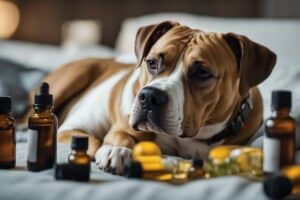Bulldogs, with their distinctive looks and charming personalities, are beloved companions to many.
Unfortunately, these sweet-natured dogs are prone to a variety of health issues, one of the more common being dry eye, a condition medically known as Keratoconjunctivitis Sicca (KCS).
This condition arises when the eyes produce fewer tears, leading to uncomfortable dryness and, if left untreated, potentially serious complications.
Bulldogs are particularly susceptible due to their unique head and face structure, which can affect tear production and drainage.

Managing dry eye in bulldogs often requires a holistic approach that not only treats the symptoms but also supports overall eye health.
Owners can explore natural remedies that complement traditional treatments recommended by veterinarians.
These may include natural tear stimulants or lubricating eye drops that offer relief.
Regular eye check-ups are crucial for early detection and management, as bulldogs may not always show obvious signs of discomfort despite the irritation they experience.
Understanding Dry Eye in Bulldogs

Dry Eye, medically known as Keratoconjunctivitis Sicca (KCS), is a common condition in Bulldogs that affects the quality and quantity of tear production, which is vital for eye health.
Causes of Dry Eye
Tear Gland Issues: Bulldogs are susceptible to various factors that can disrupt the normal function of their tear glands.
These issues can include:
- Immune-mediated diseases targeting tear-producing glands
- Neurological disorders affecting nerve supply
- Physical trauma to the eye area
Environmental and Health Factors: Bulldogs’ tear production can also be compromised by other factors such as infections, drug reactions, or systemic health problems like hypothyroidism.
Identifying Symptoms and Diagnosis
Symptoms of Dry Eye: Bulldogs with dry eye typically exhibit certain symptoms, including:
- Dull or cloudy eyes
- Excessive blinking or squinting
- A thick, mucus-like discharge from the eyes
Schirmer Tear Test: To diagnose dry eye in Bulldogs, veterinarians often use the Schirmer Tear Test which measures the amount of tear production.
A low reading indicates inadequate tear film, confirming the presence of KCS.
Bulldogs’ Predisposition to Eye Conditions
Bulldogs have a genetic predisposition to certain eye conditions, including dry eye.
Their facial structure, characterized by shallow eye sockets and prominent eyes, can exacerbate issues related to tear film and tear production.
These anatomical features necessitate extra vigilance and care for Bulldog owners to prevent and manage eye health problems such as dry eye.
Medical Interventions for Dry Eye

When dealing with dry eye in Bulldogs, two primary medical interventions are typically considered: prescription medications and surgical options.
Effectively managing the condition often requires a combination of treatments aimed at improving tear production and providing relief to the affected animal.
Prescription Medications
Veterinarians often prescribe immune-modulating drugs, like cyclosporine or tacrolimus.
These medications help to stimulate tear production and can sometimes lead to a significant improvement in tear film over the cornea.
An initial response might take several weeks, and treatment is generally long-term.
Another pharmaceutical intervention may include pilocarpine, especially if the dry eye is a result of nerve damage.
It’s usually administered orally and works by promoting tear secretion.
Alongside these, artificial tears are a staple treatment for supplementing natural tear production and keeping the eyes moist.
- Medications to Enhance Tear Production
- Cyclosporine: applied typically twice daily.
- Tacrolimus: similar to cyclosporine, used if the former is ineffective.
- Medications for Immediate Relief
- Artificial Tears: offered several times a day to maintain moisture.
Surgical Options and Considerations
When medications are not sufficient to manage dry eye, or in more severe cases, surgical options may be explored.
The surgical approach depends on the underlying cause of dry eye and the individual dog’s condition.
Surgical intervention aims to either restore tear production to a certain level or to reroute existing bodily fluids to help lubricate the eye.
Surgical treatments might include procedures to clear out blocked tear ducts, or in certain cases, the implantation of a parotid duct transposition, which redirects saliva to moisten the eye.
It’s critical for pet owners to understand that while surgery can be highly effective, it can also carry risks and should be a decision made in careful consultation with a skilled veterinarian.
Daily Management and Care At Home

Managing dry eye in Bulldogs involves a commitment to daily treatment and preventative care.
Owners can significantly improve their Bulldog’s eye health through home treatment strategies and by taking steps to enhance tear production.
Home Treatment Strategies
- Owners should routinely check their Bulldog’s eyes for signs of redness, discharge, or discomfort.
- Gently clean their eyes daily with a soft, damp cloth to ward off any gunk and keep infections at bay.
- Applying a vet-recommended eye lubricant can alleviate dryness; these lubricants often contain water and oil components to mimic natural tears and provide much-needed moisture.
- Staying well-hydrated is also key, so always have fresh water available for your dog, especially during hot weather spells.
- You can also boost their overall health with a balanced diet, especially one that includes omega-3 fatty acids, like those found in fish oil supplements.
- To keep their environment as eye-friendly as possible, use a humidifier to add moisture to the air and keep them away from smoke and dust.
- A gentle stroke on their eyelids can encourage natural blinking, and when they’re out and about, protective eyewear can shield their eyes from irritants.
- Maintaining a calm, stress-free home can do wonders for their overall well-being, including their eye health.
Improving Tear Quality and Quantity
Veterinarians may prescribe an ointment or drops designed to stimulate tear production.
Certain home remedies, such as adding flaxseed oil to a Bulldog’s diet, may be beneficial—though owners should consult their vet before trying any new treatments.
It’s important to follow a consistent routine as inconsistency can lead to an aggravation of symptoms.
Complications and Associated Conditions

When dry eye in Bulldogs isn’t managed properly, it can lead to serious complications affecting their well-being and quality of life.
The lack of adequate tear production makes their eyes vulnerable to a range of associated conditions, including infections and vision impairment.
Secondary Infections and Inflammation
Infection and inflammation are common complications arising from dry eye in dogs.
Bulldogs with insufficient tear production may suffer from conjunctivitis, where the eye tissue becomes inflamed, often accompanied by discomfort and redness.
The presence of corneal ulcers can also occur, which are painful open sores on the cornea that could lead to scarring.
Treatment typically includes antibiotics to prevent or combat bacterial infections, and Bulldogs might require anti-inflammatory medications to reduce swelling and discomfort.
Impact on Vision and Quality of Life
The persistent lack of moisture due to dry eye can lead to scarring of the cornea.
Bulldogs could suffer from impaired vision or blindness if the condition progresses without intervention.
Ensuring Bulldogs remain comfortable and maintain a good quality of life involves managing their condition to prevent these serious outcomes.
Vision loss, even when partial, can lead to discomfort and risks a Bulldog’s safety as their ability to navigate their surroundings becomes compromised.
Breeds at Risk and Preventative Measures

Certain dog breeds are predisposed to developing Keratoconjunctivitis Sicca (KCS), also known as dry eye.
Bulldogs, particularly English Bulldogs, along with Cocker Spaniels, Pugs, Shih Tzus, Boston Terriers, Lhasa Apsos, Schnauzers, American Cocker Spaniels, West Highland White Terriers, and some terriers, are among the breeds at an increased risk for this condition.
Preventative Measures:
- Regular Check-Ups: Routine veterinary eye examinations can help in early detection and management of dry eye.
- Diet and Nutrition: A well-balanced diet rich in omega-3 fatty acids may support eye health.
- Environmental Adjustments: Reducing exposure to wind, dust, and irritants can help minimize eye dryness.
- Eye Hygiene: Keeping the area around the eyes clean may prevent infections that could exacerbate dry eye symptoms.















